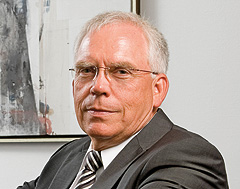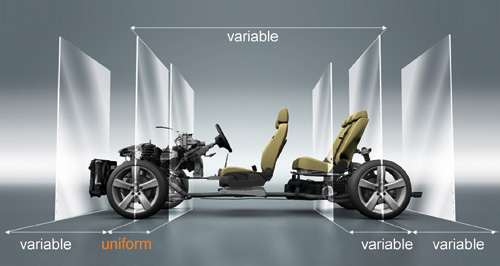Make / Model Search
Future models - VolkswagenVolkswagen to expand platform reachModel platform: Up to four million cars a year will be built on the modular MQB platform by the end of the decade. All-new modular platform will underpin up to 40 VW Group models by 201812 Mar 2012 By BYRON MATHIOUDAKIS in GENEVA VOLKSWAGEN’S vaunted new MQB transverse-engine platform architecture will underpin as many as four million vehicles a year by 2018 and encompass up to 40 different models within the VW Group. Senior engineer and VW board member Ulrich Hackenberg, the father of the MQB – which translates in English to Modular Transverse Matrix – told the Australian media at the Geneva motor show last week it would bring massive economies of scale and profitability potential to the German car-maker. Dr Hackenberg said the initial investment in money and time has been much greater than usual because of the different needs of each of the four marques using it – Volkswagen, Audi, Skoda and Seat – but that the expected dividends will ultimately more than compensate. “The first amount of money to invest is higher because you have to think through all the segments and think through all the brands,” he said. “You have to create a very intensive collaboration with all the brands because all the brands have different demands coming from the market, so we have to collect that and create a system that can fit all their demands. “MQB cost more money to develop, but then if you buy all the parts and then have the total car and then maybe have 40 or more cars based on this system then it’s much less expensive and we saved maybe 20 per cent on material costs. “We will save time now for all the cars that are coming. “For the first cars, we needed a little bit more time because we had to think of more things than you have to with a single car.”  Left: VW board member Ulrich Hackenberg.Work commenced on MQB during 2007 after Dr Hackenberg helped develop and implement the philosophically similar MLB (Modular Longitudinal Matrix) system that has underpinned every Audi since 2006 apart from the Q7 SUV and R8 supercar. Left: VW board member Ulrich Hackenberg.Work commenced on MQB during 2007 after Dr Hackenberg helped develop and implement the philosophically similar MLB (Modular Longitudinal Matrix) system that has underpinned every Audi since 2006 apart from the Q7 SUV and R8 supercar.To help future-proof the Volkswagen Group over the course of the next decade or so, three distinct MQB variations have been created according to the vehicle class requirements – MQB-0 (Polo class – light), MQB-A (Golf class – small) and MQB-B (Passat class – medium). Engineered for both front-drive and all-wheel-drive formats, each can accommodate hatchbacks, sedans, wagons, crossovers and SUVs. Consequently, the MQB-0 and MQB-A classes will each be available in three sizes while MQB-B will offer two lengths. The new-generation Audi A3 revealed at the Geneva show is the first production MQB-A vehicle and will be followed by the seventh-generation Golf at the Paris show in September, then the new Seat Leon, Volkswagen Touran (a seven-seat Golf-based MPV) and second-generation Tiguan SUV. The third-generation Skoda Fabia will debut the MQB-0 platform late this year or in 2013. While the next-generation Passat will introduce the MQB-B, the one-time closely related Audi A4 will again be a completely different car to the Passat as it will continue with an evolution of the MLB that first debuted with the A5 in 2006. As an example of the MQB modularity, while the new A3 sits on a 2530mm wheelbase, other Volkswagen Group vehicles using the MQB-A can employ 2580mm or 2630mm wheelbases as well as different track measurements. Dr Hackenberg said this simple approach to modularity is at the heart of its usefulness as a vehicle platform and for production scheduling. “We are doing it in a very simple way – we have one tool for the floor and we can cut it different lengths,” he said. He said MQB will continue to evolve with engines, transmissions and suspensions, but that the basic architecture will remain for the foreseeable future. This has real benefits for production because Volkswagen can alter output in different plants around the world producing the same architecture as required. “If one model is not so successful in the market then you can drop the production volume for that one and increase the production volume for the one that is successful,” he said. Sitting below and above these MQB architectures, meanwhile, are the newly developed NSF (New Small Family) platform underpinning the Volkswagen Up and its clones, and the large rear-drive/AWD platform (Modular Sports car Matrix) developed off the Porsche Panamera. While NSF is a different platform to the MQB, its 1.0-litre drivetrain has been developed to be employed across the two architectures to help keep costs down. “The most important thing about the MQB is that the engine and the gearbox and the suspension have a specific position. In the old platforms we had vehicles with totally different packaging. “So with the MQB we have standardised the positions, and we have standardised these too with the Up, so it is possible to have the drivetrain of the Up and place it in the MQB. “We can take the three-cylinder engine in the Up and place it in the Polo or Golf. “From the cost point of view, that is very good for the Up because we can have higher volumes for the most expensive parts of that car – the drivetrain.”  Read moreAll motor show Alfa Romeo Alfa Romeo Abarth Abarth Alpine Alpine Alpina Alpina Audi Audi Aston Martin Aston Martin BMW BMW Bentley Bentley Chery Chery Brabham Brabham Chrysler Chrysler Chevrolet Chevrolet Cupra Cupra Citroen Citroen DS DS Dodge Dodge Fiat Fiat Ferrari Ferrari Foton Foton Ford Ford Great Wall Great Wall FPV FPV Haval Haval GWM GWM Honda Honda Holden Holden Hummer Hummer HSV HSV Infiniti Infiniti Hyundai Hyundai Jaguar Jaguar Isuzu Isuzu Kia Kia Jeep Jeep Land Rover Land Rover Lamborghini Lamborghini Lexus Lexus LDV LDV Mahindra Mahindra Lotus Lotus Mazda Mazda Maserati Maserati Mercedes-AMG Mercedes-AMG McLaren McLaren MG MG Mercedes-Benz Mercedes-Benz Mitsubishi Mitsubishi Mini Mini Opel Opel Nissan Nissan Peugeot Peugeot Pagani Pagani Proton Proton Porsche Porsche Renault Renault Ram Ram Rover Rover Rolls-Royce Rolls-Royce Skoda Skoda Saab Saab SsangYong SsangYong Smart Smart Suzuki Suzuki Subaru Subaru Toyota Toyota Tesla Tesla Volvo VolvoMotor industry news |
Click to shareAll motor show Alfa Romeo Alfa Romeo Abarth Abarth Alpine Alpine Alpina Alpina Audi Audi Aston Martin Aston Martin BMW BMW Bentley Bentley Chery Chery Brabham Brabham Chrysler Chrysler Chevrolet Chevrolet Cupra Cupra Citroen Citroen DS DS Dodge Dodge Fiat Fiat Ferrari Ferrari Foton Foton Ford Ford Great Wall Great Wall FPV FPV Haval Haval GWM GWM Honda Honda Holden Holden Hummer Hummer HSV HSV Infiniti Infiniti Hyundai Hyundai Jaguar Jaguar Isuzu Isuzu Kia Kia Jeep Jeep Land Rover Land Rover Lamborghini Lamborghini Lexus Lexus LDV LDV Mahindra Mahindra Lotus Lotus Mazda Mazda Maserati Maserati Mercedes-AMG Mercedes-AMG McLaren McLaren MG MG Mercedes-Benz Mercedes-Benz Mitsubishi Mitsubishi Mini Mini Opel Opel Nissan Nissan Peugeot Peugeot Pagani Pagani Proton Proton Porsche Porsche Renault Renault Ram Ram Rover Rover Rolls-Royce Rolls-Royce Skoda Skoda Saab Saab SsangYong SsangYong Smart Smart Suzuki Suzuki Subaru Subaru Toyota Toyota Tesla Tesla Volvo VolvoMotor industry news |










Facebook Twitter Instagram